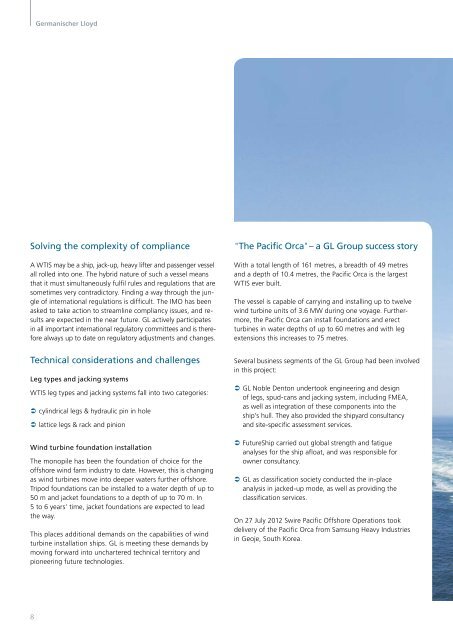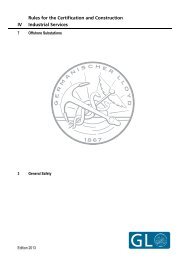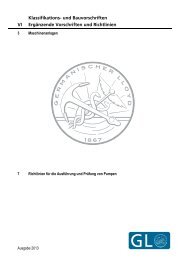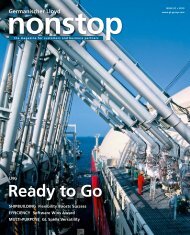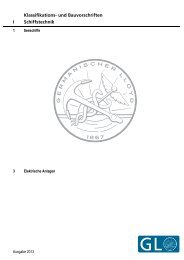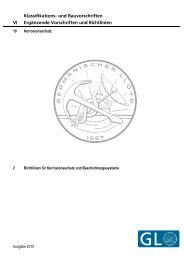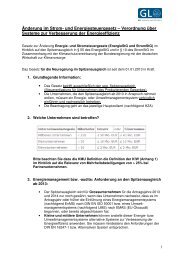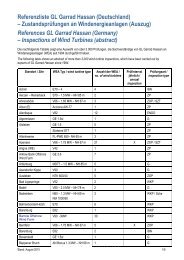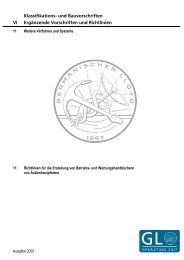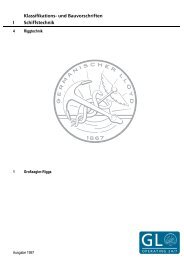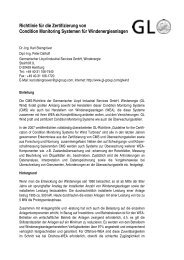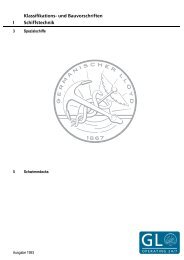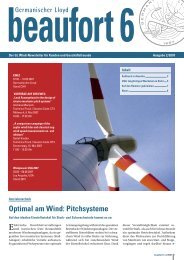GL – Mapping the Future in Offshore Wind - Germanischer Lloyd
GL – Mapping the Future in Offshore Wind - Germanischer Lloyd
GL – Mapping the Future in Offshore Wind - Germanischer Lloyd
Create successful ePaper yourself
Turn your PDF publications into a flip-book with our unique Google optimized e-Paper software.
Solv<strong>in</strong>g <strong>the</strong> complexity of compliance<br />
A WTIS may be a ship, jack-up, heavy lifter and passenger vessel<br />
all rolled <strong>in</strong>to one. The hybrid nature of such a vessel means<br />
that it must simultaneously fulfil rules and regulations that are<br />
sometimes very contradictory. F<strong>in</strong>d<strong>in</strong>g a way through <strong>the</strong> jungle<br />
of <strong>in</strong>ternational regulations is difficult. The IMO has been<br />
asked to take action to streaml<strong>in</strong>e compliancy issues, and results<br />
are expected <strong>in</strong> <strong>the</strong> near future. <strong>GL</strong> actively participates<br />
<strong>in</strong> all important <strong>in</strong>ternational regulatory committees and is <strong>the</strong>refore<br />
always up to date on regulatory adjustments and changes.<br />
"The Pacific Orca" <strong>–</strong> a <strong>GL</strong> Group success story<br />
With a total length of 161 metres, a breadth of 49 metres<br />
and a depth of 10.4 metres, <strong>the</strong> Pacific Orca is <strong>the</strong> largest<br />
WTIS ever built.<br />
The vessel is capable of carry<strong>in</strong>g and <strong>in</strong>stall<strong>in</strong>g up to twelve<br />
w<strong>in</strong>d turb<strong>in</strong>e units of 3.6 MW dur<strong>in</strong>g one voyage. Fur<strong>the</strong>rmore,<br />
<strong>the</strong> Pacific Orca can <strong>in</strong>stall foundations and erect<br />
turb<strong>in</strong>es <strong>in</strong> water depths of up to 60 metres and with leg<br />
extensions this <strong>in</strong>creases to 75 metres.<br />
Technical considerations and challenges<br />
Leg types and jack<strong>in</strong>g systems<br />
WTIS leg types and jack<strong>in</strong>g systems fall <strong>in</strong>to two categories:<br />
ÂÂcyl<strong>in</strong>drical legs & hydraulic p<strong>in</strong> <strong>in</strong> hole<br />
ÂÂlattice legs & rack and p<strong>in</strong>ion<br />
W<strong>in</strong>d turb<strong>in</strong>e foundation <strong>in</strong>stallation<br />
The monopile has been <strong>the</strong> foundation of choice for <strong>the</strong><br />
offshore w<strong>in</strong>d farm <strong>in</strong>dustry to date. However, this is chang<strong>in</strong>g<br />
as w<strong>in</strong>d turb<strong>in</strong>es move <strong>in</strong>to deeper waters fur<strong>the</strong>r offshore.<br />
Tripod foundations can be <strong>in</strong>stalled to a water depth of up to<br />
50 m and jacket foundations to a depth of up to 70 m. In<br />
5 to 6 years’ time, jacket foundations are expected to lead<br />
<strong>the</strong> way.<br />
This places additional demands on <strong>the</strong> capabilities of w<strong>in</strong>d<br />
turb<strong>in</strong>e <strong>in</strong>stallation ships. <strong>GL</strong> is meet<strong>in</strong>g <strong>the</strong>se demands by<br />
mov<strong>in</strong>g forward <strong>in</strong>to unchartered technical territory and<br />
pioneer<strong>in</strong>g future technologies.<br />
Several bus<strong>in</strong>ess segments of <strong>the</strong> <strong>GL</strong> Group had been <strong>in</strong>volved<br />
<strong>in</strong> this project:<br />
ÂÂ<strong>GL</strong> Noble Denton undertook eng<strong>in</strong>eer<strong>in</strong>g and design<br />
of legs, spud-cans and jack<strong>in</strong>g system, <strong>in</strong>clud<strong>in</strong>g FMEA,<br />
as well as <strong>in</strong>tegration of <strong>the</strong>se components <strong>in</strong>to <strong>the</strong><br />
ship’s hull. They also provided <strong>the</strong> shipyard consultancy<br />
and site-specific assessment services.<br />
ÂÂ<strong>Future</strong>Ship carried out global strength and fatigue<br />
analyses for <strong>the</strong> ship afloat, and was responsible for<br />
owner consultancy.<br />
ÂÂ<strong>GL</strong> as classification society conducted <strong>the</strong> <strong>in</strong>-place<br />
analysis <strong>in</strong> jacked-up mode, as well as provid<strong>in</strong>g <strong>the</strong><br />
classification services.<br />
On 27 July 2012 Swire Pacific <strong>Offshore</strong> Operations took<br />
delivery of <strong>the</strong> Pacific Orca from Samsung Heavy Industries<br />
<strong>in</strong> Geoje, South Korea.<br />
8


